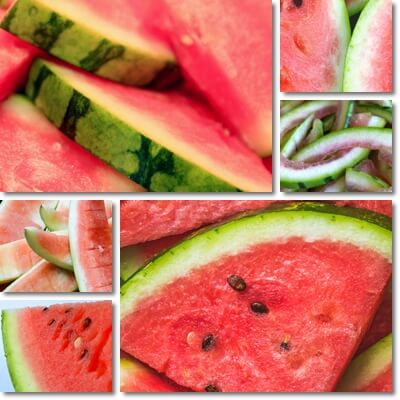The white part of a watermelon located between the colorful flesh and tough green outer skin is part of the watermelon rind and is called simply watermelon rind.
However, unlike the green part of the rind, the white part is perfectly safe to eat raw, as well as good for health. Not only is it edible, but the white part of the watermelon rind contains important antioxidants and other bioactive components with scientifically proven benefits for health, including the amino acid citrulline with vasodilating properties and subsequent benefits for high blood pressure.
What is the white part of the watermelon rind?
The white part of the watermelon looks like a sort of greenish-white watermelon flesh. It’s juicy and crisp, with a consistency like watermelon flesh, but harder, and a relatively bland taste with little flavor overall.
Most people choose not to eat it because it’s just not sweet like watermelon flesh. But despite it seemingly being an extension of watermelon flesh, the white part of a watermelon is actually part of the watermelon rind.
For lack of a better term, it’s called ‘the white part of watermelon rind’ or simply watermelon rind. It may also be referred to as the ‘inner surface of watermelon rind’.

Can you eat the white part of the watermelon rind?
The white part of a watermelon rind is both edible and safe to eat raw, cooked, juiced, candied, pickled, stewed or however you may want to eat it. You can pretty much eat the whole watermelon: the sweet juicy flesh and seeds and the whole rind, including the tough green outer green skin and the white part. Except for the tough outer skin which is edible cooked, pickled, candied or ground and dried (watermelon rind extract), but not raw, the flesh, seeds and white part are edible raw, as they are.
White part of watermelon: benefits
Are there any benefits to eating the white part of a watermelon? The white part of a watermelon is actually good for you and a source of several biologically active components with impressive health benefits. For example, the amino acid citrulline which has anti-hypertensive benefits, boosts exercise performance and male stamina via its circulatory benefits.

Source of citrulline
Watermelon rind, including the white part, is a natural source of citrulline, a non-essential but highly biologically active amino acid.
Citrulline has antioxidant and vasodilating properties and provides a range of circulatory benefits that extend to include benefits for multiple organs and systems, including muscles and the male reproductive system.
Wild watermelons grown in the desert are highest in citrulline. As for domesticated watermelon, yellow fleshed watermelon as well as orange fleshed watermelon are higher in citrulline than the more common red watermelon.
Seedless Hazera and Summergold or Summer Gold had the best content of citrulline among 14 varieties studied with 28 mg of citrulline/g dry weight (source).
Circulatory benefits
Citrulline from the white part of watermelon rind helps synthesize and raise levels of the amino acid arginine in the blood. Arginine is vital for the production of nitric oxide for the circulatory system which is used to regulate blood pressure and maintain a healthy endothelium (inner surface of blood vessels). It further holds benefits for angina, or chest pain, and can contribute to overall better cardiovascular health.
Anti-hypertensive benefits
Eating the white part of watermelon rind is good for you if you have high blood pressure. The white part of a watermelon rind contains citrulline which helps synthesize arginine which then helps synthesize nitric oxide.
Nitric oxide is used as a biological messenger that signals to blood vessel muscles to relax which dilates blood vessels and improves blood flow, resulting in benefits such as lower blood pressure numbers.
In addition to watermelon rind white part, outer watermelon rind (the green skin) and the flesh also contain citrulline with the same benefits for blood pressure.
Find out what are the benefits of citrulline for blood pressure.
Benefits for muscle oxygenation and exercise performance
Citrulline in the white part of watermelon rind contributes to nitric oxide production which lowers blood pressure numbers and improves blood flow. Better blood flow improves oxygenation of muscles and supports normal muscle function. Better blood flow together with lower blood pressure numbers boosts exercise performance.
See the benefits of citrulline for muscles.
Benefits for stamina in men
Eating the white part of watermelon rind helps boost production of arginine which is then used by the body to make nitric oxide and achieve vasodilation (dilation of blood vessels) and improved blood flow. Improved blood flow and better cardiovascular health in men can help boost stamina, although effects may be more pregnant with citrulline supplements from watermelon rind extract for example.
Antioxidant benefits
Your watermelon white part is a source of antioxidants such as the amino acid citrulline, but also pigmented and non-pigmented antioxidants with free radical-scavenging properties. Antioxidants help prevent, reduce and even repair cell damage caused by oxidative stress.
Source of fiber and micro-nutrients
If you do decide to eat the less flavorful white part of watermelon, know that you will be increasing your fiber intake and enjoy benefits such as better digestion, regular transit and natural constipation relief. your watermelon white part will also provide trace amounts of essential vitamins and minerals to contribute to your nutritional status, including potassium, vitamin C and B vitamins.
Lower sugar content
In addition to helping fill you up, the white part of a watermelon rind is also naturally lower in sugar compared to the flesh. So while it may not be as sweet, it should not raise blood sugar levels as much and can be good for diabetics.
